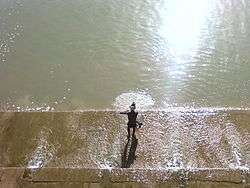Lower Anaicut
The Lower Anaicut or Anaikkarai is a dam and bridge built on the Kollidam (the northern tributary of Kaveri River) in the Indian state of Tamil Nadu.

It was built in 1902 by the colonial administration of the Madras Presidency for irrigating the erstwhile South Arcot district. Stones from the ruins of Gangaikonda Cholapuram were used to construct the dam. It is situated about 70 miles below the Upper Anaicut and 100km from Kumbakonam.[1][2][3] It has a shutter and sluice system that distributes the Kollidam water into various waterways.[4] At Lower Anaicut, the Kollidam branches off into Manniar and Uppanai.[5]
Lower Anaicut is the terminal barrage across the Kaveri river system for sharing the river water per Cauvery Water Dispute Tribunal. 10 tmcft water is allocated for the minimum environmental flows in the dowm stream of the Lower Anaicut. Another 4 tmcft is identified as unavoidable wastage to the sea from the Lower Anaicut/river basin. If Tamil Nadu is unable to use the available Kaveri waters and water over flows downstream of Lower Anaicut in excess of 14 tmcft, the excess water gone to sea is considered as part of the utilisable water under the share of Tamil Nadu per the Kaveri Water Dispute Tribunal.[6]
References
- W. Francis. Gazetteer of South India. p. 156.
- J. W. Bond, Arnold Wright (1914). Southern India: its history, people, commerce, and industrial resources. p. 288. ISBN 978-81-206-1344-7.
- R. Nagaswamy. Gangaikondacholapuram. 1970: State Dept. of Archaeology, Govt of Tamil Nadu. p. 17.CS1 maint: location (link)
- "Renovation at Anaikarai bridge". The Hindu. 23 June 2011. Retrieved 28 November 2011.
- "Agriculture". Thanjavur district website. Retrieved 28 November 2011.
- "Final Order of Cauvery Water Disputes Tribunal" (PDF). 2007. Archived from the original (PDF) on 7 October 2016. Retrieved 15 September 2016.